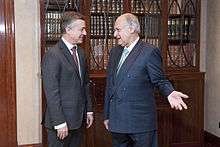Manuel Elkin Patarroyo
| Manuel Elkin Patarroyo | |
|---|---|
 Manuel Elkin Patarroyo is on the right | |
| Born |
Manuel Elkin Patarroyo Murillo November 3, 1946 Ataco, Tolima, Colombia |
| Education |
National University of Colombia (MD) Rockefeller University (Ph.D) |
| Known for | Malaria license |
| Medical career | |
| Profession | Doctor |
| Institutions | Hospital San Juan de Dios, Bogota, National University of Colombia |
| Specialism | Pathologist |
| Research | Immunology |
| Notable prizes | Prince of Asturias Awards (1994) Robert Koch Prize (1994) |
Manuel Elkin Patarroyo (born November 3, 1946)[1] is a Colombian Professor of Pathology and Immunology who made the world's first attempt to create a synthetic vaccine against a parasite called the protozoa Plasmodium falciparum that causes severe malaria,[2] a disease transmitted by mosquitoes that affects millions of people and is one of the leading causes of death (~1.5 million people per year) in tropical and subtropical regions, including parts of the Americas, Asia, and Africa.
The vaccine candidate, first developed in 1987 in Colombia, was evaluated in clinical trials carried out by the WHO in Gambia, Tanzania and Thailand, and had mixed results.[3] In 2009, a comprehensive Cochrane review assessed the SPf66 as being not efficacious in Africa and Asia, and as having a low but statistically significant efficacy of 28% in South America.[4] Today, after more than 33 years of research, there is still however no licensed malaria vaccine. Researchers and vaccine developers have been working on many approaches to bring forward the availability of a malaria vaccine."[5] More research and clinical trials are required for a universal vaccine to be implemented.
Patarroyo is a recipient of the TWAS Prize (1998).[6]
References
- ↑ Fundación Príncipe de Asturias. Manuel Elkin Patarroyo (Spanish). Premiados, Investigación Científica y Técnica, 1994.
- ↑ Holloway, M. (1996) Profile: Manuel Elkin Patarroyo – The Man Who Would Conquer Malaria, Scientific American 275(6), 52-56.
- ↑ - Susan Aldridge, Magic Molecules: How Drugs Work (Cambridge University Press, 1998), p. 89
- ↑ - Graves, P. M. and Gelband, H. (2009) Vaccines for preventing malaria (SPf66) (Review), The Cochrane Library 2009, (2), pp.1-38.
- ↑ - WHO (2010) Tables of Malaria Vaccine Projects Globally (Updated December 2010), Initiative for Vaccine Research.
- ↑ "Prizes and Awards". The World Academy of Sciences. 2016.
External links
- Structural and Immunological Principles Leading to Chemically Synthesized, Multiantigenic, Multistage, Minimal Subunit-Based Vaccine Development, abstract of article in Chemical Reviews, from de American Chemical Society.
- Emerging Rules for Subunit-Based, Multiantigenic, Multistage Chemically Synthesized Vaccines, abstract of article in Accounts of Chemical Research, from the American Chemical Society.
- Toward A New Generation Of Vaccines For Malaria And Other Diseases in 'Science Daily'.
- Race for Malaria Money
- Scientists Herald Malaria Breakthrough
- Guardian Unlimited: Scientist whose dream of beating disease came true
- Tables of Malaria Vaccine Projects